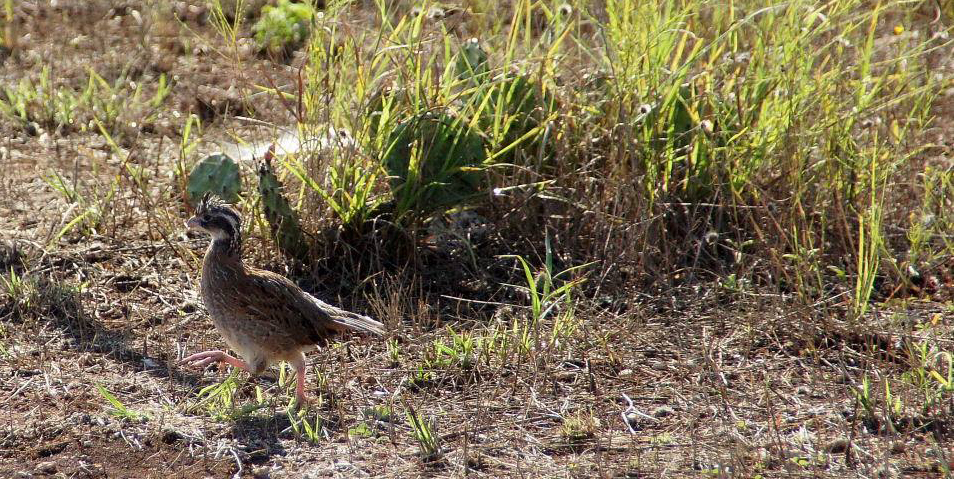A decline in Texas quail populations over the past couple of decades is a single, undeniable fact, but the exact reasons for the decline are myriad. Drought and red imported fire ants have been identified as possible causes for the decline, but the primary reason identified is loss of suitable habitat.
While we may not be able to control some reasons for loss of habitat – urban sprawl, for example – we can control how we treat our respective necks of the woods. In short, private landowners are the key to restoring quail populations. And from the cultural to the ecological, there are as many reasons for creating habits to increase wild quail populations as there are reasons for their decline.
Bobwhite and scaled or “blue” quail are the most common species of quail in Texas; the bobwhite, in particular, has long been a popular part of Texas’ cultural heritage. Stable populations of both are not only an indication of healthy rangeland and ecosystems, they’re also an economic boon for Texas thanks to dedicated quail hunters from around the country.
“Habitat management is nine-tenths of bobwhite management.” – Fred Guthery, Beef, Brush and Bobwhites
To create a habitat suitable for quail requires a handful of efforts to make a big impact for a little bird. The following highlights key aspects of quail management as suggested by the Natural Resources Conservation Service:
Food: The mainstay of the quail diet for the majority of the year is seed from forbs, woody plants, hard-seeded grasses and even some agricultural crops. Seeds high in oil are especially important. And, when available, quail prefer insects. The availability of food is an important part of quail habitat. If your land is lacking in this area, consider supplementing with a food plot with “double duty” plants like legumes that not only provide nutrition themselves, but also attract insects which are particularly important for young quail during the first ten weeks of life.
Cover: Quail cannot live by food alone, they must have the right kind of cover in the right amounts. The constant threat of predation and vulnerability to adverse weather makes adequate cover the most critical part of quail habitat. While at least six different specific kinds of cover have been identified for quail – nesting, brooding, screening, loafing, roosting and escape – just two basic habitat attributes will usually suffice to provide needed cover: adequate grass and adequate brush.
Water: A good supply of insects and fleshy fruits provide the majority of the water needed by quail. When these food items are eaten, they also provide water. “Free water” from ponds, creeks, puddles, troughs or dew is a desirable but not essential part of quail habitat, but when insects and succulent vegetation are not present, surface water may be provided. For example, overflow areas from traditional livestock water development, ground level watering devices, or modifications of livestock water troughs can be used to provide surface water. As another benefit, they also create green spots which attract insects. Adequate water is particularly essential to nesting hens that require extra water during the egg laying period – without it, egg production will be low.
Habitat Arrangement: The proper interspersion of cover and food is especially critical for suitable quail habitat. Different cover types and food need to be very closely intermixed. In good quail habitat, birds will not have to venture more than 50 to 100 feet from low shrubby cover. A variety of food plants should be found growing in and among nest cover, screening cover, and brooding cover. A large variety and abundance of insects will be found when there is a diversity of grasses, forbs and shrubs. The presence and interspersion of surface water is less critical since quail derive most of their water from foods.
Habitat Size: While it has been suggested that about 800 birds may be the minimum required to maintain a viable long-term population of quail, anecdotal reports indicate private landowners with smaller pieces of land that would sustain far fewer are finding levels of success as individual quail and coveys normally spend the great majority of their lives in a rather small area. Bobwhite quail, for example, usually live in areas of 20 to 40 acres. Therefore, if bobwhite habitat is desired across a tract of 1,000-acres, all habitat components would need to be present on each and every 40-acre area.
From the call of bob-white! bob-white! to the sight of a flushed covey of quail rising from cover, the simple aesthetic appeal of quail may be reason enough for many to make the effort to help these unique, native Texas birds flourish again. For in-depth details of each of the above aspects of quail management, be sure to check out the Natural Resources Conservation Service Conservation Practice Standard, Upland Wildlife Habitat Management, Texas Supplement, Zone 5, Bobwhite and Scaled Quail. Don’t be put off by the ponderous title, the downloadable PDF contains plenty of easy to understand information. Also, another great resource for more information and quail habitat management inspiration is Where Have All the Quail Gone? The Texas Quail Conservation Initiative: A Proactive Approach to Restoring Quail Populations By Improving Wildlife Habitat by the Texas Quail Initiative
PHOTO: Courtesy Melanie Cambron









